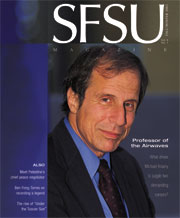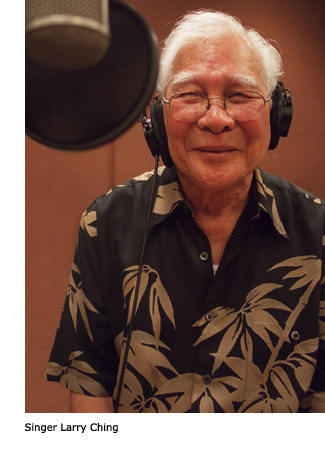 |
| |||
In the Studio With Larry Making my way through the mini-maze that is the basement of the old Creative Arts building, in search of CA 43 and the recording studios where I'd soon be producing a CD with a legendary local crooner, I couldn't help feeling how right this was. After all, I'd been a student at San Francisco State some 40 years ago, and spent many hours upstairs, attending broadcasting classes and playing DJ on the campus station. I shuttled between Creative Arts and the Journalism Department, where I edited and wrote for the Daily Gater. There -- at the radio station and the newspaper office -- I took what turned out to be the first steps toward a career in rock journalism, beginning, in 1968, at a new newspaper in the South of Market. It was called Rolling Stone. By then, I'd graduated with a major in Radio-TV-Film, a minor in journalism, and a passion for chronicling the scene I'd observed on (and off) campus. The scene, of course, was the '60s. At Rolling Stone, I worked alongside John Burks, who'd preceded me by a couple of years as an editor at the Gater. Today, Burks is chair of the Journalism Department, and he's cajoled me into several stints as a fill-in instructor, bringing me back to campus on a regular basis. But it was serendipity that SF State would be where I'd produce my first CD ever. The album is called "Till the End of Time," and it is anything but rock. The artist was Larry Ching, who'd been a star back in the '40s and '50s at Forbidden City, an all-Asian nightclub on the outskirts of San Francisco's Chinatown. He was billed as "the Chinese Sinatra," although, unlike the Chairman, Ching had a sweet tenor voice, imported from his native Hawaii. By 1961, Forbidden City was closed, and Ching gave up on singing as a profession. Outside of the Asian clubs, there wasn't exactly a demand for Chinese crooners. In 1989, he and many of his fellow performers were featured in alumnus Arthur Dong's documentary, "Forbidden City, USA," and when I co-emceed the film's premiere, I met Larry and heard him sing. Intrigued by his voice, which transported me back to the pop music I'd enjoyed before rock rolled along, and by his history as a pioneer entertainer, I began thinking about getting him on record. Larry, who'd cut only a few demos, readily agreed. But, owing to jobs and other distractions, I never got around to it. Then, last November, we met again, at an event at SF State celebrating the DVD edition of "Forbidden City, USA." Once again,I was emceeing; once again, Larry sang. At 82, he was still sounding fine. Encouraged by members of his family, I became determined to get him into a studio. That's when serendipity stepped in. I've long known John Barsotti, professor in Broadcast and Electronic Communication Arts and a veteran record producer, and when I mentioned my idea, he volunteered his studios and his services. Suddenly, "Till the End of Time's" time had come. Up in the control room, I mostly pretended to be a producer. Writing for Rolling Stone, I'd watched some of the best at work -- from artists like Ray Charles and Paul Simon to producers who made albums with Crosby, Stills & Nash, Linda Ronstadt, Jefferson Starship, and Diana Ross. But, faced with a huge audio mixing board and an array of microphones and other equipment, I was just grateful for Barsotti's presence. With his knowledge of every element of record-making, I could relax and simply chip in thoughts, here and there, about how a particular song sounded. That almost wasn't fast enough. Because the building had to be shut down by 8:30 p.m., I had to push to get all 12 songs in. When Ching began to tire, and to make mistakes, I had to confer with Barsotti to see if we could use technology to fix or mask the errors, rather than put Larry and the band through additional takes. Just often enough, we could, and we wrapped the session just in time. "Wow, that's the hardest work I've ever done," Ching said afterwards. But he did it, and after several sessions at Barsotti's home studios, where we reviewed, tweaked and mixed every track of every tune, we had a CD. It came out in June, which, unbeknownst to anybody, would be Larry's last month of life. But what a month. He drew attention from radio and television stations and from newspapers and Web sites. Surrounded by family, fans and fellow Forbidden City alumni, he celebrated the CD at a party at the Chinese Historical Society of America in Chinatown. Mayor Willie Brown proclaimed that day, June 25, as "Larry Ching Day" in San Francisco. And then, a week later, he died of a brain aneurysm. The timing was nothing short of stunning. Newscaster Emerald Yeh, who co-emceed "The Forbidden City" premiere with me in 1989, wrote to me shortly after Larry's death: "The timing could not have been more ideal. You let him soar from the world with joy and a sense of being appreciated, as well as a chance to relive the height of his career." I'd like to think that he said "Aloha" with a song in his heart, sung with a tender tenor voice that, thanks to a short session in a basement studio at San Francisco State, will last ⦠till the end of time. Ben Fong-Torres(B.A., '66) was SFSU Alumnus of the Year for 2003 and was recently inducted into the Alumni Hall of Fame. For more information on the CD Fong-Torres produced, visit www.larryching.com.
| ||||









 By Ben Fong-Torres
By Ben Fong-Torres One weekend afternoon in February, in CA 43, the team gathered: Larry, his friend and pianist George Yamasaki, and two ace session players, standup bassist Dean Reilly and drummer Jim Zimmerman. One of Barsotti's students served as assistant engineer. Later in the day, other students dropped by to watch, listen and learn.
One weekend afternoon in February, in CA 43, the team gathered: Larry, his friend and pianist George Yamasaki, and two ace session players, standup bassist Dean Reilly and drummer Jim Zimmerman. One of Barsotti's students served as assistant engineer. Later in the day, other students dropped by to watch, listen and learn. Most of them sounded great, and Larry and company nailed several tunes in one take. Within about three hours of recording, we completed the dozen tracks Yamasaki and I had selected, from a swinging "All of Me" to a plaintive "Prisoner of Love" to a gorgeous "Hawaiian Wedding Song."
Most of them sounded great, and Larry and company nailed several tunes in one take. Within about three hours of recording, we completed the dozen tracks Yamasaki and I had selected, from a swinging "All of Me" to a plaintive "Prisoner of Love" to a gorgeous "Hawaiian Wedding Song."